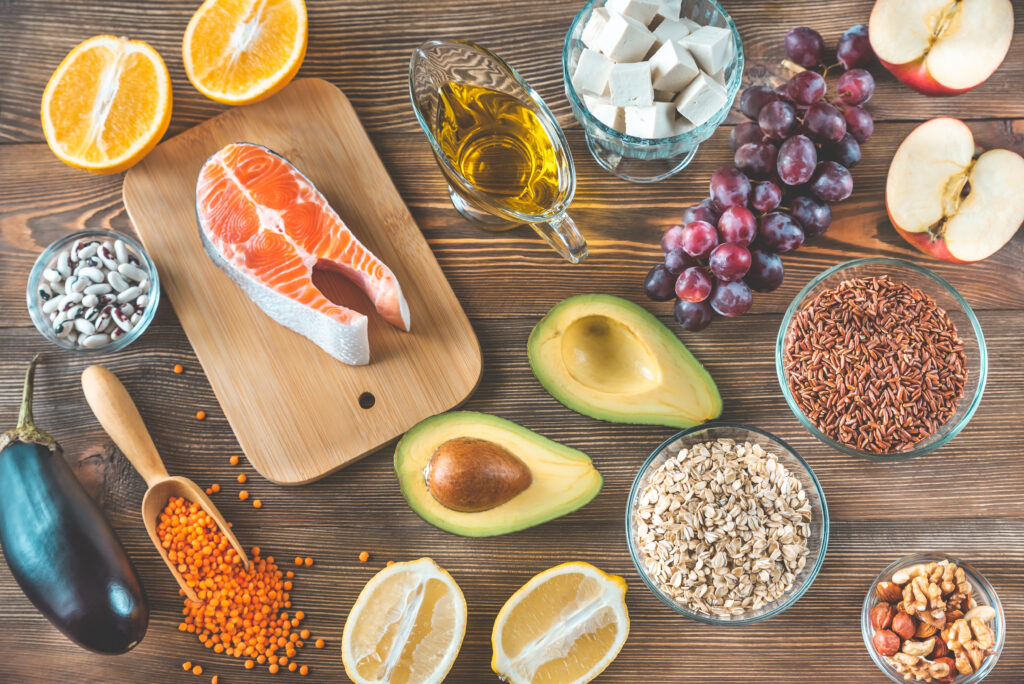
Understanding the Link Between Age and Cholesterol Levels
Risk Factors for High Cholesterol in Different Age Groups
Have you ever wondered why cholesterol levels seem to change as we age? It’s a fascinating journey that our bodies undertake, and understanding it is crucial when considering what is the best diet to reduce cholesterol.
Cholesterol, a waxy substance found in our blood, is essential for building cells and producing hormones. However, as we age, our body’s ability to manage cholesterol can become less efficient, leading to an increased risk of high cholesterol levels. This change isn’t uniform across all ages, though, and different age groups face distinct risk factors.
Young Adults: In our 20s and 30s, lifestyle choices play a significant role in determining cholesterol levels. Poor dietary habits, such as high intake of saturated and trans fats, combined with a sedentary lifestyle, contribute significantly to elevated cholesterol. During these years, it’s crucial to establish healthy eating patterns that focus on whole grains, fruits, and vegetables—an essential part of what is considered the best diet to reduce cholesterol.
Middle Age: As we enter our 40s and 50s, our metabolism naturally slows down, and cholesterol levels can rise. Hormonal changes, particularly in women undergoing menopause, can further exacerbate this issue. At this stage, incorporating foods rich in omega-3 fatty acids, like fish and flaxseeds, and soluble fiber, such as oats and beans, becomes even more important. These foods help maintain heart health and manage cholesterol levels effectively.
Older Adults: For those in their 60s and beyond, high cholesterol may be influenced by additional factors such as genetics and chronic conditions like diabetes or hypertension. Here, the focus should be on a low-cholesterol diet that minimizes processed foods and emphasizes nutrient-dense options.
It’s worth noting that cholesterol levels are not solely determined by diet. Genetics, overall health, and lifestyle choices, including physical activity, all play a significant role. However, making informed dietary choices can have a substantial impact.
So, what’s the takeaway? Regardless of age, adopting a heart-healthy diet that includes a variety of fruits, vegetables, lean proteins, and whole grains can help manage cholesterol levels. Not only does this approach cater to our body’s changing needs as we age, but it also provides a blueprint for what is the best diet to reduce cholesterol in the long term.
The journey of understanding cholesterol is ongoing, and while age presents its challenges, it also offers opportunities to make conscious health choices. By embracing these changes, we can work towards healthier cholesterol levels and a more vibrant life.
Exploring the Primary Sources of Dietary Cholesterol
Common Foods High in Dietary Cholesterol and How They Impact Health
Picture this: you’re standing in the supermarket aisle, pondering which foods to add to your basket to support a heart-healthy lifestyle. If you’re on a quest to discover what is the best diet to reduce cholesterol, knowing which foods are high in dietary cholesterol is a crucial step in making informed choices.
Dietary cholesterol is the cholesterol found in the foods we eat. While our bodies naturally produce cholesterol, consuming too much can lead to elevated levels in the blood, increasing the risk of heart disease. But here’s the twist: not all cholesterol-rich foods impact our blood cholesterol levels in the same way.
Eggs: Often the poster child for dietary cholesterol, eggs have been both celebrated and vilified over the years. A single egg contains about 186 milligrams of cholesterol, primarily in the yolk. However, recent studies suggest that for most people, moderate egg consumption does not significantly raise cholesterol levels in the blood. Instead, it’s the saturated and trans fats in your diet that have a more profound impact (Zhong et al., 2019).
Red Meat and Processed Meats: Foods like beef, lamb, and pork, along with processed meats such as sausages and bacon, are high in both cholesterol and saturated fats. These can raise LDL (low-density lipoprotein) cholesterol, often referred to as “bad” cholesterol, which is a major contributor to artery-clogging plaque.
Shellfish: Shrimp, crab, and lobster are delicious options that also contain high levels of cholesterol. However, they are low in saturated fat, making them a better choice if consumed in moderation. The key is to be mindful of preparation methods—steaming over frying can make a big difference.
Dairy Products: Full-fat dairy products, including cheese, butter, and cream, are significant sources of both cholesterol and saturated fats. Opting for low-fat or non-fat versions can help manage cholesterol intake without sacrificing flavor.
Understanding these primary sources of dietary cholesterol allows us to tailor our eating habits. For those wondering about the best diet to reduce cholesterol, the focus should be on minimizing foods high in saturated and trans fats, rather than eliminating cholesterol-rich foods altogether.
Instead, incorporate more fruits, vegetables, whole grains, and lean proteins, which are naturally low in cholesterol and saturated fats. By doing so, you not only support your heart health but also enjoy a varied and nutritious diet.
In essence, while dietary cholesterol deserves attention, it’s one piece of the puzzle. By balancing your intake and making mindful food choices, you can create a diet that not only reduces cholesterol but also enhances overall well-being.
Debunking the Myth: How Diet Impacts Cholesterol Levels
Unpacking the Relationship Between Sugar Intake and Cholesterol
When we think of reducing cholesterol, our minds often drift to cutting down on fatty foods. But here’s a plot twist that might surprise you: sugar, not just fat, plays a significant role in the cholesterol story. So, how exactly does sugar intake affect cholesterol levels, and what is the best diet to reduce cholesterol?
First, let’s address a common misconception: cholesterol issues are solely a result of eating too much fat. While dietary fats, particularly saturated and trans fats, are well-known contributors to high cholesterol, sugar is an often-overlooked culprit that can wreak havoc on our lipid profile.
The Sugar-Cholesterol Connection: Consuming high amounts of sugar, particularly added sugars found in sodas, sweets, and processed foods, can lead to an increase in triglycerides, a type of fat in the blood. Elevated triglyceride levels are known to lower HDL (high-density lipoprotein) cholesterol, often dubbed the “good” cholesterol, which helps remove LDL (“bad”) cholesterol from the arteries.
Moreover, diets high in sugar can contribute to obesity and insulin resistance, both of which are risk factors for developing heart disease. When our bodies process excessive sugar, it can lead to increased production of lipids in the liver, resulting in higher cholesterol levels (Te Morenga et al., 2014).
Rethinking Our Diets: So, what does this mean for those searching for the best diet to reduce cholesterol? It suggests a shift in focus—not just cutting back on fatty foods but also being mindful of sugar intake. Here are some practical steps to consider:
- Choose Whole Foods: Prioritize whole grains, fruits, and vegetables, which provide natural sugars and fiber, helping to keep cholesterol levels in check.
- Read Labels: Be vigilant about reading food labels to identify and limit added sugars. Opt for unsweetened or naturally sweetened products whenever possible.
- Limit Processed Foods: Reduce consumption of processed and packaged foods, which are often laden with hidden sugars.
- Mindful Sweeteners: Consider using natural sweeteners like honey or maple syrup in moderation, and wean off artificial sweeteners, which can increase sugar cravings.
Ultimately, understanding the sugar-cholesterol relationship empowers us to make better dietary decisions. By reducing added sugars and focusing on a balanced diet rich in whole foods, we not only work towards lowering cholesterol but also improve overall health.
In the grand puzzle of heart health, it’s vital to piece together all the factors, including sugar, that influence our cholesterol levels. By doing so, we can develop a comprehensive dietary approach that fosters long-term well-being.
Practical Tips for Lowering Cholesterol Through Diet
Incorporating Heart-Healthy Foods: A Practical Guide for Lowering Cholesterol
Embarking on a journey to manage cholesterol can feel like navigating through a maze of dietary advice. But fear not—understanding what is the best diet to reduce cholesterol involves a few straightforward steps, and it all starts with incorporating heart-healthy foods into your daily meals.
The Power of Soluble Fiber: One of the most effective ways to reduce cholesterol is by increasing your intake of soluble fiber. This type of fiber dissolves in water to form a gel-like substance in the gut, which helps lower the absorption of cholesterol into the bloodstream. Foods rich in soluble fiber include oats, barley, beans, lentils, and fruits like apples and pears. Aim to include these in your diet regularly; for instance, start your day with a hearty bowl of oatmeal topped with fresh fruit.
Embrace Healthy Fats: Not all fats are created equal. Replacing saturated and trans fats with unsaturated fats can significantly lower LDL cholesterol levels. Incorporate sources of healthy fats such as avocados, nuts, seeds, and olive oil into your meals. These not only support heart health but also add flavor and satisfaction to your dishes.
Plant Sterols and Stanols: Naturally occurring in plants, sterols and stanols can block the absorption of cholesterol in the intestine, effectively lowering LDL cholesterol. Foods like fortified margarine, orange juice, and yogurt drinks contain added sterols and stanols. Including these in your diet can be a handy tool in your cholesterol-lowering arsenal (Demonty et al., 2009).
Fish for Omega-3s: Fatty fish like salmon, mackerel, and sardines are excellent sources of omega-3 fatty acids, which can reduce triglycerides and support cardiovascular health. Try to include fish in your meals at least twice a week, opting for grilled or baked preparations to keep them healthy and delicious.
Go Nuts for Nuts: Nuts are not only a convenient snack but also a powerful ally in managing cholesterol. Almonds, walnuts, and pistachios, in particular, have been shown to improve cholesterol levels. A small handful a day can make a significant difference, offering a crunchy, satisfying way to boost heart health.
By integrating these heart-healthy foods into your daily routine, you’ll be well on your way to crafting the best diet to reduce cholesterol. Remember, it’s about making sustainable changes that fit your lifestyle, so start small and gradually build up your repertoire of cholesterol-friendly foods.
With each mindful choice, you pave the way towards better heart health and a vibrant, cholesterol-conscious life. It’s not just about the numbers; it’s about feeling empowered and informed to make choices that benefit your well-being now and in the future.
Innovative Ways to Incorporate Cholesterol-Lowering Foods
Spice Up Your Diet: How Herbs and Spices Can Help Lower Cholesterol
When it comes to discovering what is the best diet to reduce cholesterol, the answer might be lurking in your spice rack. Herbs and spices not only add flavor and excitement to meals but also come packed with cholesterol-lowering properties, offering a deliciously innovative approach to heart health.
Cinnamon’s Sweet Surprise: This aromatic spice isn’t just for desserts. Studies suggest that cinnamon can help lower LDL cholesterol and triglycerides, making it a sweet addition to your heart-healthy diet. Sprinkle cinnamon on your morning oatmeal, blend it into smoothies, or even use it to add depth to savory dishes like curries and stews.
Garlic’s Heart-Healthy Punch: Known for its potent flavor, garlic has been celebrated for its medicinal properties for centuries. Research indicates that consuming garlic can lead to modest reductions in cholesterol levels. Add fresh garlic to your cooking, whether sautéing with vegetables, mixing into dressings, or roasting whole cloves for a mellow, sweet taste.
Turmeric’s Golden Glow: Turmeric, with its active compound curcumin, has powerful anti-inflammatory and cholesterol-lowering effects. Incorporate turmeric into your diet by adding a dash to soups, stews, or even your morning latte for a golden, health-boosting elixir.
Peppermint’s Refreshing Twist: While often associated with fresh breath, peppermint contains antioxidants that may contribute to heart health. Consider incorporating peppermint tea into your routine or using fresh mint leaves in salads and smoothies to enjoy its benefits.
Basil and Beyond: Basil, along with other herbs like oregano and parsley, can be used generously to add flavor without the need for extra salt or fat. These herbs contain antioxidants that support heart health, so feel free to use them lavishly in your cooking.
The Versatility of Cayenne Pepper: If you like a bit of heat, cayenne pepper can be a fantastic addition. Its capsaicin content may help lower cholesterol levels and improve circulation. Use it to spice up soups, sauces, and marinades for a fiery kick.
Incorporating these herbs and spices into your meals is an effortless way to enhance the flavor and health benefits of your diet. They allow you to reduce reliance on less healthy flavor enhancers like salt and sugar, which can negatively impact cholesterol levels.
By embracing the vibrant world of herbs and spices, you not only make your meals more exciting but also take a proactive step towards establishing the best diet to reduce cholesterol. It’s a flavorful journey that invites creativity and curiosity, all while supporting your heart health.
So, next time you reach for the salt shaker, consider experimenting with these natural flavor boosters instead. Your taste buds—and your heart—will thank you. Learn more about atherosclerosis and heart disease in our article


